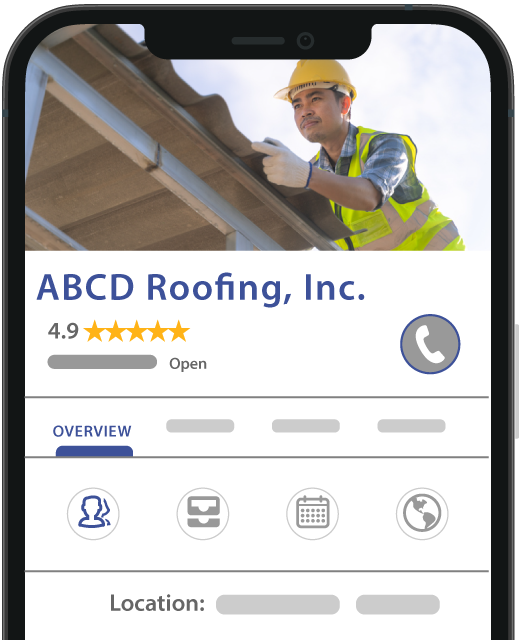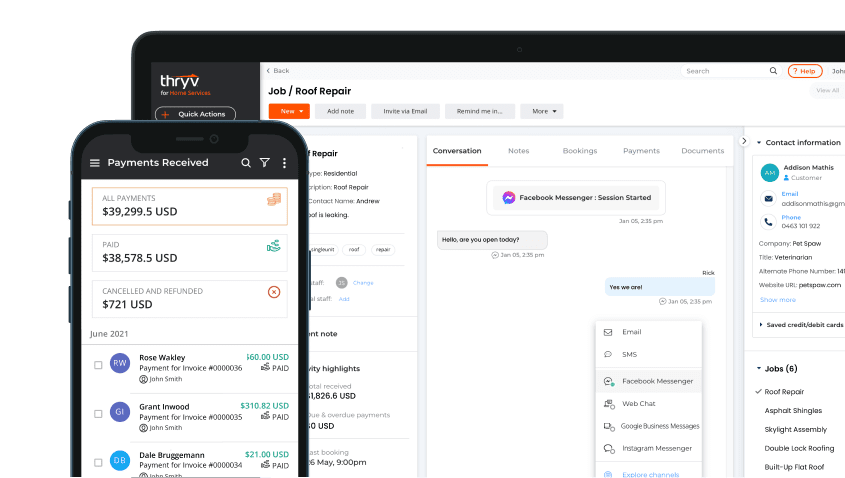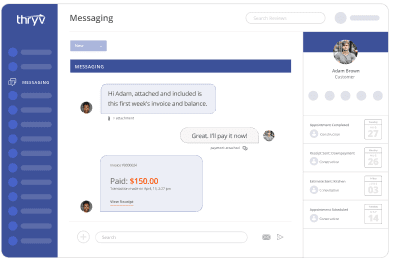The Small Business Owner’s Guide to Pricing for Roofing Work
In the roofing business, getting your pricing strategy right can make or break your success. Price too low, and you risk losing money or looking unprofessional. Price too high, and you might scare off potential customers. That’s why it’s important to have a clear, consistent approach to setting your roofing prices – one that reflects your expertise, covers your costs, and meets your business goals. With the right methods, tools, and mindset, you can build the right pricing for roofing jobs that earns trust, wins you work, and sets the foundation for long-term growth.
Whether you’re just learning how to start a roofing business or looking to tighten up your quotes, this guide will help you approach roofing pricing with confidence.
Understand the basics of roofing pricing
Pricing for roofing work isn’t one-size-fits-all. To calculate the right roofing price, you’ll need to consider multiple factors, each of which plays a critical role in your final estimate.
Consider the following items when pricing your roofing jobs:
- Roof size and complexity: Larger roofs require more materials and longer labor hours. But size isn’t the only consideration – design complexity can dramatically increase costs. Multi-level homes, steep pitches, skylights, chimneys, dormers, and architectural valleys all add time and risk, which should be reflected in your pricing. More complicated designs may also require special tools and additional safety equipment.
- Material choices: Not all roofing materials are equal in terms of cost, durability, and installation difficulty. Asphalt shingles are cost-effective and quick to install, making them popular for standard residential jobs. Metal roofing is more expensive upfront but offers long-term durability and is especially popular in hurricane-prone states like Florida. Slate and tile deliver high-end curb appeal but require expert installation and structural reinforcement, which drives up both labor and material costs. Your roofing pricing should always align with the specific material you choose to go with.
- Labor and overhead: Labor is often the largest part of the roofing price. This includes not just wages for your crew but also workers’ compensation insurance, payroll taxes, training, and benefits. Overhead costs – like fuel, vehicles, office staff, uniforms, and software for roofing – also need to be factored in. Many small business owners forget to include their own salary or the cost of downtime between jobs, which can eat into profitability.
- Permits and compliance: Pricing for roofing jobs should include the cost of obtaining permits and ensuring your work meets local building codes. These fees vary by city and state and can include inspection costs, environmental surcharges, and more. Your roofing license may also need to be renewed periodically, and the cost of continuing education or legal compliance should be rolled into your overall pricing structure.
- Markup for profit: Once you’ve accounted for hard costs and overhead, it’s time to add your profit margin. This is the portion of your roofing pricing that allows you to invest back into your business, build reserves, and grow sustainably. A typical markup might range from 10% to 30%, depending on the job type and local market conditions. Don’t be afraid to charge what your work is worth – your time, reputation, and experience are part of what makes your service valuable.
A roofing calculator can help you ballpark costs, but you’ll still need to do some homework to fine-tune your estimate. Real-world pricing requires a thoughtful approach and a deep understanding of your business expenses and customer needs.
Common roofing pricing models
Not sure how to structure your bids? Here are a few common approaches to roofing pricing, each with its own strengths and limitations:
- Per square foot: This is one of the most straightforward pricing models and works well for standard, predictable jobs. You calculate the total roof area in square feet and multiply it by a fixed rate that includes materials, labor, and overhead. It’s efficient, easy for customers to understand, and helps speed up the quoting process. However, this model doesn’t always account for unusual complexities, like steep slopes, architectural features, or site access issues, which can make the final roofing price less accurate if not adjusted accordingly.
- Flat rate pricing: With this model, you provide a single price for the entire job, regardless of actual hours worked or materials used. It’s great for highly repeatable jobs or services like basic roof repairs or inspections. Many customers like the simplicity and predictability of flat rates. For you, it speeds up bidding and invoicing. The risk, however, is that any unanticipated costs, like hidden damage or last-minute material changes, can eat into your profit. Be sure to build in a cushion to protect your margins.
- Time and materials: This flexible model charges for the actual hours worked and materials used. It’s ideal for complex, open-ended, or emergency repair jobs where the full scope isn’t clear at the outset. You can bill as you go and adjust for real-time costs, which can protect your business from unexpected expenses. The downside is that customers may feel nervous about open-ended pricing. They might worry that the roofing price will balloon. To build trust, provide estimates upfront, explain your rates clearly, and update customers as the job progresses.
No matter which method you choose, be clear and transparent in your quote. Break down materials, labor, and any optional upgrades. This not only builds trust but also reduces the chance of pricing disputes later on.
How to calculate your roofing price
Getting your roofing pricing right involves a bit of math and a lot of planning. Follow these steps to land on a fair, profitable price:
- Measure the roof: Start by accurately measuring the roof’s surface area. You can do this manually using a tape measure and pitch gauge or opt for aerial mapping and drone technology for faster, more precise measurements. Don’t forget to account for overhangs, valleys, dormers, and roof pitch, which all affect total square footage and material needs.
- Choose materials: Once you know the size, calculate exactly what materials you’ll need. This includes shingles or panels, underlayment, flashing, ridge caps, drip edge, nails, vents, sealants, and ice and water shields. Material selection should match customer preferences, local climate conditions, and roof design. Higher-end materials or specialty products will raise the roofing price, so make sure customers understand the trade-offs in durability, appearance, and cost.
- Estimate labor time: Factor in how long the job will take based on your crew size and the roof’s complexity. Consider setup, teardown, disposal, and safety prep. Plan for weather-related delays and access challenges like steep pitches or limited space. Labor costs should also reflect local wage expectations, crew experience, and any premium rates for emergency or weekend work.
- Add overhead: Build in all business-related costs not tied to a specific job. This includes vehicle maintenance, office rent, software for roofing businesses, phones, safety gear, marketing, insurance, and your own salary. These fixed and variable costs should be divided across all your jobs to make sure each roofing price contributes fairly to your business expenses.
- Include markup: Finally, add your profit margin. This should be enough to reward your efforts and support future growth. A common starting range is 10–20%, but high-demand areas or complex jobs may justify more. Markup should be clearly noted in your pricing model so you’re consistently applying it across all quotes.
tools for roofing professionals, like templates, spreadsheets, and apps, can make these steps easier and more consistent. They also help you produce professional-looking quotes and track your profitability over time. A good roofing calculator can simplify these inputs and provide a quick estimate, but your pricing should always reflect real-world experience and business-specific needs.
Avoid underpricing traps
Roofers sometimes undercharge to win jobs – but that can backfire fast. Here are a few underpricing traps to avoid:
- Skipping overhead: When you leave out overhead costs – like insurance, gas, equipment maintenance, admin salaries, or tools – you may win the job but you’ll lose money in the long run. Overhead is often invisible to customers, but it’s real and recurring. Failing to account for these costs in your roofing price means you’re essentially paying out of your own pocket to finish each job.
- Forgetting your value: You’re not just charging for shingles and nails – you’re charging for your knowledge, skills, and time. If you have a roofing license, professional training, and years of experience, your pricing should reflect that. customers don’t just hire you for labor – they hire you for peace of mind and quality workmanship. Undervaluing yourself sets a precedent that’s hard to undo.
- Caving to customer pressure: It’s natural for homeowners to ask for a discount or shop around. While a little negotiation is part of the process, avoid slashing your roofing pricing just to make the sale. That creates a race to the bottom, where your margins disappear and you take on more work for less reward. Instead, emphasize value, offer tiered options, or include a small bonus service rather than cutting the price.
A strong reputation and smart roofing marketing efforts can help you attract customers who value quality over the lowest bid. When your work speaks for itself, your pricing becomes a reflection of trust – not just numbers on a page.
Keep improving your pricing strategy
The price for roofing work isn’t static. Materials fluctuate, labor costs rise, and your crew and service area may expand. That’s why it’s essential to treat your pricing strategy as a living part of your business – not a set-it-and-forget-it task.
Here are a few ways to continuously refine and improve your roofing pricing:
- Raising rates as demand grows: As your schedule fills up, your experience increases, and your reputation grows, you’ve earned the right to raise your rates. Higher demand means you can be more selective about jobs – and charge a premium for your expertise.
- Offering upgrade options for higher margins: Don’t just quote the basics. Present premium options like upgraded shingles, solar-ready roofing, extended warranties, or enhanced underlayment. These options not only increase revenue per job but also give customers more control over their budget and expectations.
- Using a CRM or pricing app to track estimate accuracy: A CRM (Customer Relationship Management system) or dedicated pricing tool helps you analyze past quotes, actual costs, and profitability. You can identify which jobs came in over or under budget and fine-tune your future estimates based on real data.
- Asking for feedback from past customers to improve transparency: After each project, ask customers how they felt about the pricing process. Was it clear? Did they feel surprised or well-informed? Their input can highlight gaps in communication or areas to clarify in future quotes.
Regularly reviewing your pricing strategy keeps you competitive, profitable, and aligned with your business goals. It also shows your customers that you’re professional, organized, and committed to delivering value.
How Thryv helps you price roofing jobs and run your business smarter
Thryv’s industry-leading software is built specifically for small business owners who want to run more efficiently, look more professional, and grow faster. It combines essential tools – like scheduling, invoicing, marketing, and customer communication – into one simple software. You can access it from anywhere, whether you’re on a job site or at home, and it integrates seamlessly with the software you already use. That means less time switching between apps and more time focusing on your business.
When it comes to pricing for roofing, Thryv gives you the tools to quote fast, follow up professionally, and keep every job on track.
- Create and send estimates on the go: Build polished quotes from your phone or tablet.
- Track jobs and customer info: See past jobs, prices, and communications all in one place.
- Automate follow-ups: Send reminders and next steps to keep deals moving.
- Organize licenses and documents: Store your roofing license, permits, contracts, and more.
- Centralize communication: Use one inbox to manage customer messages, appointment requests, and approvals.
Beyond pricing, Thryv helps with scheduling, billing, payments, and marketing – so you can focus on growth. Whether you’re learning how to start a roofing business or scaling a team, Thryv has your back.
Additional Resources
Free Tools for Roofing Businesses
Small Business Software for Roofing Businesses



